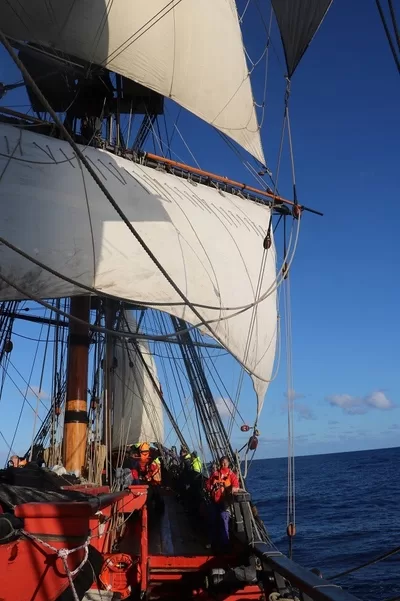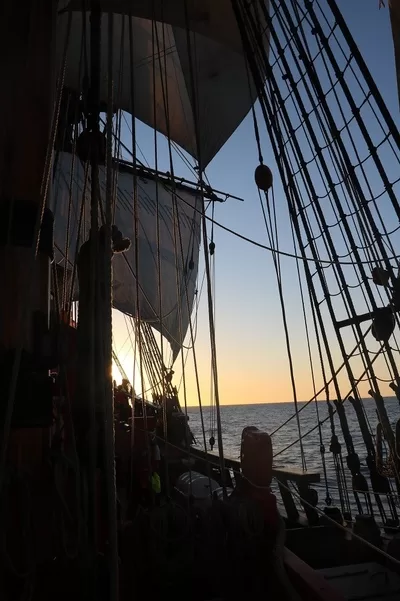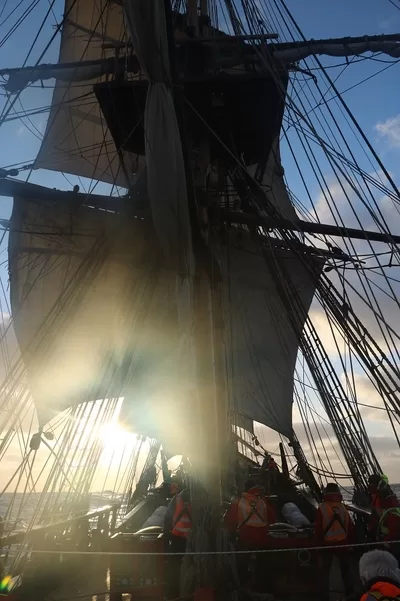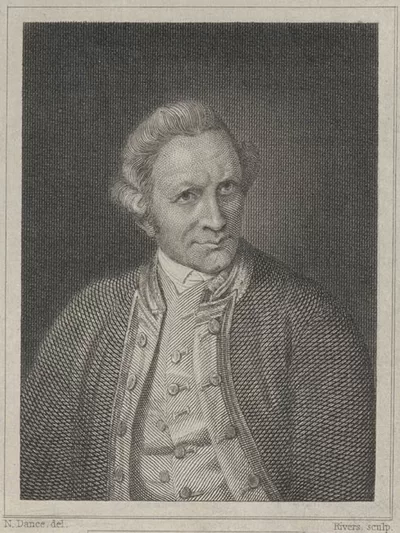In 1778, only seven years after Cook’s historic First Voyage to the South Seas, the British Navy deliberately sank (scuttled) his ship, the HMB Endeavour by then renamed the Lord Sandwich, in Newport Harbor.
There, at the bottom of the harbor in the United States, the Endeavour lay forgotten for over two centuries before being positively identified as Cook’s ship in 2022.
British forces scuttled five ships in Newport Harbour to create a blockade as French warships approached during the American War of Independence. The exact location and identification of Cook’s ship remained a mystery.
A 22-year program of research and field work by the Rhode Island Marine Archaeology Project led Mr Kevin Sumption, Director and CEO of the Australian National Maritime Museum, to conclude that the Newport Harbor, Rhode Island USA site known as RI 2394 is the location of remains of the HMB Endeavour.
“Although only around 15% of the vessel remains, the focus is now on what can be done to protect and preserve it. The museum continues to work closely with maritime experts in Rhode Island and of course with the Australian, Rhode Island and US Governments to secure the site.”
“Since 1999, we have been investigating several 18th century shipwrecks in a two square mile area where we believed that Endeavour sank, however, the last pieces of the puzzle had to be confirmed before I felt able to make this call.”
Mr Kevin Sumption, Director and CEO of the Australian National Maritime Museum said in 2022
Positively identifying the Endeavour
There are several key identifiers that set Endeavour apart from the four other ships sunk in Newport in August 1778.
Historical evidence indicates that the Lord Sandwich (formerly Endeavour) was scuttled just to the north of Goat Island in Newport Harbor along with four other British transports.
Lord Sandwich was the largest by far of the five scuttled transports in that area.
Archaeological evidence indicates the site of RI 2394 is significantly larger than any of the other 18th century shipwreck sites.
The length of the surviving hull is almost exactly the same as that recorded for Endeavour.
The structural details and shape of the remains closely match historic plans of Endeavour.
There are specific diagnostic clues such as the construction of the keel along the bottom of the wreck, the joinery used in its bow at the front and the placement of the vessel’s fore and main mast which are identical to those shown on 18th century plans of Endeavour.
Timber samples strongly suggest a vessel built in Europe, not America.



Earl of Pembroke / Her Majesty’s Bark Endeavour / Lord Sandwich
Originally launched in 1764 as the Earl of Pembroke,
In 1768 the vessel was renamed Her Majesty’s Bark Endeavour by Britain’s Royal Navy and prepared for a major scientific voyage to the Pacific.
The vessel is famous in Australia and New Zealand as James Cook’s Endeavour. Cook’s First Voyage during 1768 to 1771 was important for the British.
Firstly, Cook and the scientists on board Endeavour observed the transit of Venus across the sun from Tahiti in 1769. Following the completion of that astronomical mission, the bark sailed around the South Pacific searching for the fabled Great Southern Land in 1770.
Secondly, the Endeavour’s circumnavigation of Aotearoa / New Zealand proved to the Europeans that the North and South Islands were seperate islands and not part of the Great Southern Land, and thirdly, the first map making (charting) of the east coast of the Great South Land, Australia.
Finally, the east coast, and ultimately the entire continent of Australia (New Holland), was renamed ‘New South Wales’ and ‘proclaimed’ by the British as their ‘possession’.
After returning to Britain in 1771 following their round the world voyage, Endeavour was tused by the Royal Navy as a transport to take supplies to the Falkland Islands.
In 1775, the HMB Endeavour was in poor condition, especially after striking a coral reef in 1770 and being ran aground to make repairs on a beach in Australia.
The ship was sold to a private owner, who renamed it Lord Sandwich, and used to carry goods to the Baltic before being hired by the Royal Navy in 1776 to operate as troop transport, taking soldiers to fight against the American colonists who sought to break free from British control.
Endeavour in the American War of Independence
In August 1778, the renamed Lord Sandwich was in Newport Harbor, being used as a floating jail holding American patriots who had been captured by the British.
When a French fleet of warships sailed in to support the American forces, the British forces scuttled (deliberately sank) Lord Sandwich and four other vessels Earl of Orford, Mayflower, Peggy and Yowart to create a blockade at the northern end of the Harbor in 1778.
The Endeavour / Lord Sandwich was sunk one year before Cook’s death in Hawaii (coincidentally named the Sandwich Islands at that time) while on his third Pacific voyage, and 10 years before the First Fleet of British convicts and troops arrived in New South Wales, beginning European settlement of Australia.
Cook’s famous ship Endeavour identified
Mr Kevin Sumption, Director and CEO of the Australian National Maritime Museum, confirmed in 2022 that the shipwreck of James Cook’s famous vessel, His Majesty’s Bark Endeavour, has been positively identified, 244 years after it was scuttled by the British in 1778 .
Mr Sumption stated
“I am satisfied that this is the final resting place of one of the most important and contentious vessels in Australia’s maritime history.
Based on archival and archaeological evidence, I’m convinced it’s the Endeavour.
“It’s an important historical moment, as this vessel’s role in exploration, astronomy and science applies not just to Australia, but also Aotearoa New Zealand, the United Kingdom and the United States.
Mr Sumption noted the combined efforts that led to identification of the wreck:
“We pay tribute to the work of Dr Kathy Abbass and her team at the Rhode Island Marine Archaeology Project for their ongoing commitment to the site and its history, and also acknowledge the significant contribution made by the United States of America’s Bicentennial Gift and the Silentworld Foundation in making this work possible.
“We are currently in the process of finalising our report on the site and are looking forward to that report being peer reviewed and published in due course. The archaeological work continues, and we anticipate further discussion of the evidence over the coming months. We look forward to continuing the work in Rhode Island as we move to the next phase.”
Read Captain Cook’s journal –
1. James Cook aboard His Majesty’s Bark Endeavour first sight of Australia at Point Hicks
2. James Cook journal: 20th – 28th April, 1770 on HMB Endeavour From Pt. Hicks to Kamay Botany Bay



